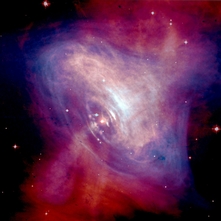Global Scans · Supernova · Weekly Summary

- [New] A supernova explosion close to Earth could be to blame for both the late Devonian and Ordovician extinction events, which occurred 372 and 445 million years ago respectively. ScienceDaily
- [New] Unlike distant supernovae, which require powerful telescopes to observe, T CrB's explosion will make it as bright as Polaris (the North Star), meaning anyone - even in urban areas-will be able to see it with the naked eye. Jegtheme
- Within the next decade, large facilities like the European Extremely Large Telescope and NASA's Roman space telescope will be able to measure galaxy distances in much larger volumes of space, while the Vera Rubin Observatory is expected to discover some 300,000 new distant supernovae per year. Sky & Telescope
- Various calamities could potentially end life on Earth, including asteroid strikes, supernova blasts, and other catastrophic events. Geographic FAQ Hub: Answers to Your Global Questions
- If a star goes supernova close enough to Earth, the gamma-ray radiation could damage some of the planetary protection that allows life to thrive on Earth. The Conversation
- In a few million years, when HD 45166 explodes as a supernova and leaves behind a neutron star, its magnetic field will be confined to a region just 12 miles (20 km) across - the size of a typical neutron star. Astronomy Magazine
- Supernova says that its focus in 2025 will be on materials development for specific industrial applications, as well as the industrialization of the product ecosystem, with the first beta systems set to be installed in 2024. DEVELOP3D
- An international team of astronomers reports the detection of a new tidal disruption event as part of All-Sky Automated Survey for SuperNovae. phys.org
- SN2023ixf provides a unique opportunity to monitor the SETI Ellipsoid of a nearby supernova within weeks of its discovery. Arxiv
- A very close supernova, closer than 30 light years, could cause major problems: the cosmic rays could cause ozone destruction and dangerous UV levels on Earth. The Conversation
- Previous observations with the Subaru Telescope have found stars with peculiar compositions that cannot be explained by ordinary core collapse supernovae, suggesting the existence of very massive stars, but there were still problems that could not be explained by theoretical models of supernovae. Subaru Telescope
- Over the next billion years, we should expect a certain amount of large asteroid or comet impacts and supernovas that are severe enough to cause mass extinctions. SpringerLink
- While gamma-ray bursts, nearby supernovae, or giant collisions with asteroids or comets could easily pose a threat to all life on our planet, a black hole offers an even more grim fate: the possibility of destroying the Earth itself entirely, perhaps even swallowing it whole. Big Think
- The star Eta Carinae at 100-150 times the mass of the Sun is a dying cataclysmic variable which is expected to explode as a supernova anytime within the next million years. Museum of Applied Arts and Sciences
- Over the next two billion years, there will be about 20 supernova explosions and one gamma ray burst that will have a significant impact on the planet's biosphere. No Agenda
- Athena - a name derived from Advanced Telescope for High-Energy Astrophysics - would launch by the mid-2030s to study supermassive black holes, supernova explosions and other sources of X-rays using a large X-ray mirror. SpaceNews
- The Carina Nebula is the home of the most luminous known star in the Milky Way, as well as the Eta Carinae binary system, which includes a massive sun expected to explode in a supernova blast in the near future. CBS News
- If the Sun was born in a region with much higher metallicity, there would be many more supernovae going off, presenting a risk to life on Earth. The Guardian
Last updated: 31 March 2025
